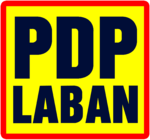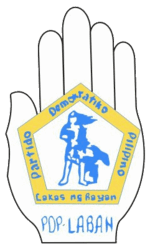PDP–Laban
PDP-Laban | |
|---|---|
 | |
| President | Aquilino Pimentel III |
| Chairman | Rodrigo Duterte |
| Spokesperson | Paola Alvarez |
| Secretary-General | Pantaleon Alvarez |
| Founder |
Aquilino Pimentel Jr. (PDP) Benigno Aquino Jr. (LABAN) |
| Founded |
February 6, 1983 (merger)[1] |
| Merger of | PDP and LABAN |
| Headquarters | Metro Manila |
| Youth wing | PDP-Laban Youth |
| Ideology |
Federalism |
| Political position | Center-left to Left-wing |
| National affiliation |
UNIDO (1982 - 1987) Koalisyong Pambansa (1992) Lakas-Laban Coalition (1995) LAMMP (1998) PPC (2001) KNP (2004) GO (2007) Team PNoy (2013) Coalition for Change (2016 - present) |
| Colors | Yellow, Dark Blue, Red |
| Seats in the Senate |
2 / 24 |
| Seats in the House of Representatives |
97 / 294 |
| Provincial governorships |
1 / 81 |
| Provincial vice governorships |
0 / 81 |
| Provincial board members |
4 / 1,006 |
| Website | |
|
www | |
The Partido Demokratiko Pilipino-Lakas ng Bayan (lit. Philippine Democratic Party-Power of the People), more commonly known as PDP–Laban, is the ruling political party in the Philippines.
History

The party now known as PDP–Laban is the result of a merger between the Partido Demokratiko Pilipino and Lakas ng Bayan.
Partido Demokratiko Pilipino (PDP) was founded in 1982 by Aquilino Pimentel, Jr. and a group of protesters against the authoritarian government of Ferdinand Marcos, the 10th President of the Philippines. These protesters include the leaders of Davao City and Cagayan de Oro City, such as Zafiro L. Respicio, Rey Magno Teves, Cesar R. Ledesma, Samuel Oceña, Crispin Lanorias and Morgs Cua.
Merger
By 1983, PDP had formed a coalition with the Lakas ng Bayan (Filipino for "People Power") party, founded earlier by former Senator Benigno Aquino, Jr. in 1978.
In 1986, the two groups merged to form the Partido Demokratiko Pilipino-Lakas ng Bayan or PDP LABAN. During that period, PDP LABAN became the single biggest opposition group to run against the presidency of Ferdinand Marcos in the 1986 Snap Presidential Elections. Corazón, the widow of the assassinated senator Aquino, became the party's nominee to run for President. Aquino was persuaded to run by businessman, newspaperman and street parliamentarian Joaquin Roces, who was convinced that Aquino would have the biggest chance to defeat Marcos in the polls.
Roces started the "Cory Aquino for President" movement to gather one million voters in one week, to urge Aquino to run for president. However, another opposition group led by Senator Salvador Laurel of Batangas was also participating in the election, with Laurel as its presidential bet. Before the election, Aquino approached Laurel and offered to give up her allegiance to the PDP-LAPAN party and run as president under Laurel's United Nationalist Democratic Organization (UNIDO) party. Laurel later approached Aquino, offering her only the Vice-Presidential nomination of UNIDO (or Unity). In the end, Laurel became the Vice-Presidential running-mate of Aquino, after being convinced to do so by the Archbishop of Manila, Jaime Cardinal Sin.
PDP-LABAN then aligned itself with UNIDO, which became the main group and leader of the coalition which opposed Marcos. After the People Power Revolution of 1986, which saw Aquino and Laurel proclaimed President and Vice President, respectively, PDP LABAN continued its alliance with UNIDO until the latter's dissolution in 1987. In 1988, PDP-LABAN was split into two factions: the Pimentel Wing of Aquilino Pimentel, Jr. and the Cojuangco Wing of Jose Cojuangco, Jr.. The Cojuangco Wing and the Lakas ng Bayan party of House Speaker Ramon Mitra, Jr. merged in 1988 to form the Laban ng Demokratikong Pilipino party.
PDP-Laban today
As of May 2016, PDP–Laban is headed by its president, senator Aquilino "Koko" Pimentel III, after the then incumbent Vice-President of the Philippines, Jejomar Binay, resigned as party chairman and left the party. The party is currently re-grouping, and there are some movements of expansion especially in Mindanao, where it originated, particularly in the Davao region. Two of the party's founders, Crispin Lanorias and Cesar Ledesma, are again active in recent party activities. After the 2016 elections, PDP–Laban signed a coalition agreement with the Nacionalista Party, Lakas-CMD, National Unity Party and the Nationalist People's Coalition, witnessed by President-elect Rodrigo Duterte.
Ideology and platform
According to self-published material, PDP-LABAN seeks a peaceful and democratic way of life characterized by:
- freedom
- solidarity
- justice, equity, and social responsibility
- self-reliance and efficiency
- enlightened nationalism
- a federal system of parliamentary government
Five basic party principles
- Theism
- Authentic humanism
- Enlightened nationalism
- Democratic centrist socialism
- Consultative and participatory democracy
Current party officials
- Aquilino "Koko" Pimentel III – president of the party; current senator and senate president
- Rodrigo Duterte – national chairman of the party; current president of the Philippines; former mayor of Davao City[3] (also a member of Hugpong Sa Tawong Lungsod, a local party based in Davao City)
- Alfonso Cusi – vice chairman of the party; current department secretary of energy
- Jorge Bernardo – executive vice president of the party
- Salvador Ty – vice president of the party for the National Capital Region
- Virgilio Bote, Jr. – vice president of the party for Luzon; incumbent Mayor of General Tinio, Nueva Ecija
- Victor Emmanuel Caindec – vice president of the party for Visayas
- Charito B. Plaza – vice president of the party for Mindanao
- Pantaleon "Bebot" Alvarez – secretary-general of the party; incumbent Davao del Norte 1st district congressman; current house speaker
- Cesar Chavez – overall deputy secretary of the party
- Norman Fulgencio – deputy secretary-general of the party for the National Capital Region
- Martin Diño – deputy secretary-general of the party for Luzon; also Chairman of the Volunteers Against Crime and Corruption
- Doloreich Dumaluan – deputy secretary-general of the party for Visayas
- Benito L. Ranque – deputy secretary-general of the party for Mindanao
- Mario Espinosa – deputy secretary-general of the party for Bicol Region
- Richard Ang – deputy secretary-general of the party for Eastern Visayas
- Raymund Saguin – deputy secretary-general of the party for Zamboanga Peninsula
- Sultan Ali A. Mindalano – deputy secretary-general of the party for Muslim Affairs
- Aquilino “Nene” Pimentel, Jr. – chairman emeritus
Notable members
Elected President of the Philippines
- Corazon Aquino (11th President of the Philippines)
- Rodrigo Duterte (16th President of the Philippines; former Mayor of Davao City; party chairman)
Elected Vice President of the Philippines
- Jejomar Binay (13th Vice President of the Philippines; former Mayor of Makati City; former party chairman; moved to UNA)
Elected legislators
- Pantaleon Alvarez (Speaker of the House for the 17th Congress; incumbent Representative from the 1st District of Davao del Norte; secretary-general of the party)
- Gwendolyn Garcia (Deputy Speaker for the 17th Congress; incumbent Representative from the 3rd District of Cebu; former governor of Cebu)
- Teodoro Locsin Jr. (former Representative from the 1st District of Makati)
- Manny Pacquiao (incumbent Senator; former Representative from the Lone District of Sarangani)
- Aquilino "Nene" Pimentel, Jr. (former Senate President; former mayor of Cagayan de Oro)
- Aquilino "Koko" Pimentel III (Senate President for the 17th Congress; president of the party)
- Lucy Torres (Wife of actor and politician Richard Gomez; incumbent Representative from the 4th District of Leyte)
Other notable members
- Allan L. Rellon – Tagum City mayor
- Amado Espino Jr. (incubment representative of the 5th District of Pangasinan and former Governor of Pangasinan)
- Ismael Sueño – former governor of South Cotabato; Secretary of the Department of Interior & Local Government,[4] former national chairman of the party
- Roy M. Yap – incumbent Board Member of the First District of Misamis Occidental; Interim Secretary-General of the party for the Province of Misamis Occidental
2016 elections
- Rodrigo Duterte (formally announced candidacy on November 21, 2015 and officially filed Certificate of Candidacy on November 27 and December 8) – WON
- Martin Diño (filed his candidacy on October 16, 2015, withdrawn on October 29)
- Note: Diño earlier stated that should he withdraw his intention to run for president, Davao City Mayor Rodrigo Duterte would be his substitute.[5]
- Vice Presidential Candidate
- Alan Peter Cayetano (PDP-LABAN guest candidate; a member of the Nacionalista Party running as an independent candidate)
References
- ↑ "THE PARTY - PDP-Laban". PDP-Laban. Retrieved June 21, 2016.
- ↑ BINAY INDUCTS NEW PDP-LABAN MEMBERS IN GMA, CAVITE - "...the PDP, established in 1982... Archived July 23, 2011, at the Wayback Machine.
- ↑ "Duterte is new PDP-Laban chair". Philippine Daily Inquirer. February 7, 2016. Retrieved February 7, 2016.
- ↑ Rody finalizes Cabinet
- ↑ "PDP-Laban decision final: Duterte to substitute if Diño withdraws presidential bid". CNN Philippines. Retrieved 2015-10-27.
